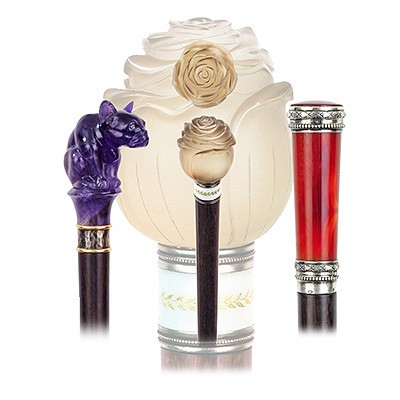Silver and Lapis Lazuli Brigg Dress Cane
Lot 4
About Seller
Kimball Sterling
125 West Market Street
Johnson City, TN 37604
United States
Family-owned and family-run Johnson City Tennessee auction business for 25 years. Selling antiques and collectables for 38 years. Kimball M. Sterling, Inc. was founded and is owned by Kimball and Victoria Sterling, time and again, they have laid solid claim to world-wide attention and renown with an...Read more
Categories
Estimate:
$600 - $800
Absentee vs Live bid
Two ways to bid:
- Leave a max absentee bid and the platform will bid on your behalf up to your maximum bid during the live auction.
- Bid live during the auction and your bids will be submitted real-time to the auctioneer.
Bid Increments
| Price | Bid Increment |
|---|---|
| $0 | $10 |
| $100 | $25 |
| $500 | $50 |
| $1,000 | $100 |
About Auction
By Kimball Sterling
Dec 3, 2022
Set Reminder
2022-12-03 13:00:00
2022-12-03 13:00:00
America/New_York
Bidsquare
Bidsquare : The 2022 Cane Masterpiece Auction
https://www.bidsquare.com/auctions/kimball-sterling/the-2022-cane-masterpiece-auction-11295
The European Masterpiece Cane Collection Kimball Sterling kimballsterling@earthlink.net
The European Masterpiece Cane Collection Kimball Sterling kimballsterling@earthlink.net
- Lot Description
-1888 -Large Lapis Lazuli knob fashioned of a select single stone of a throughout uniform blue color richly speckled with golden pyrite dust in a substantial, slightly tapering and paneled vertical configuration extending on one side with a domed and matching facetted top and, on the other, with plain and narrowing neck. -Pleasing to the eye and with an addictive, sensuous feel to the hand, the knob extends in a longer and plain collar with a classy presentation engraving on one side “A.G. \ from \ H. & D.G. \ 1888” and a full set of English silver hallmarks 1887 on the other. To the right of the hallmarks there is a “BRIGG” stamp and a “WM”, most likely for Walter Morissey. The collar extends seamless in a high-end rosewood shaft distinguished by a superb veined structure underscored by striking, reddish brown hues and a dark horn ferrule. -This cane has style and substance and demonstrates sophisticated cane art at its best. With a unique blend of English heritage and timeless European style, it is guaranteed to leave a lasting impression. -This cane is a reminder of how European trading and imperial expansion provided supplies of new materials, which were made up into fashionable commodities in European workshops. Each component of the cane, the Lapis Lazuli, the silver, the rosewood and horn probably came from a different part of the world, from territories colonized by different European powers. -It survived in superb condition and with its entire initial sparkle. -H. with collar 3 ½” x 1 ¼”, O.L. 36 ¾” -$600-$800 -Brigg Umbrella Co. was established in London in 1836, later changing its name to Brigg & Son and becoming the leading cane maker of his generation, possibly the greatest cane manufacturer and retailer of all times. The firm’s main branches were in London 23, St. James’s street and Paris 33, Avenue de l’Opéra. According to their catalog at the turn of the 20th century, they also had agencies in Nice, Madrid, Naples and Rome. For those in the know, Brigg became synonymous with gentleman luxury items and canes in particular. Its unique position in cane history and European culture owed much to the historical luminaries who wore Brigg canes, including, among others, Napoleon, Marie Antoinette, Churchill as well as the famous writers who mentioned Brigg in their works, like Pushkin, Balzac and Victor Hugo. It is said that Brigg holds a special place in our cultural heritage because its founder set the standards by which all fine cane making has since been judged. -The term “walking stick” is based upon function, but the origin of “cane” is less clear. The leading theory attributes the term to the 1500s, when walking sticks were first made of imported bamboo or malacca, members of the cane family. Still further conjecture is that “cane” dates to ancient Rome and the Latin canes, for dog, when pedestrians often carried walking sticks to defend themselves from roaming packs of canines.
- Shipping Info
-
Each auction has different shipping terms but the buyer always pays. Shipping will be delayed in this auction due to delay of customs.Canes:After payment has been received we will contact you.
- Buyer's Premium
-



 EUR
EUR CAD
CAD AUD
AUD GBP
GBP MXN
MXN HKD
HKD CNY
CNY MYR
MYR SEK
SEK SGD
SGD CHF
CHF THB
THB
















